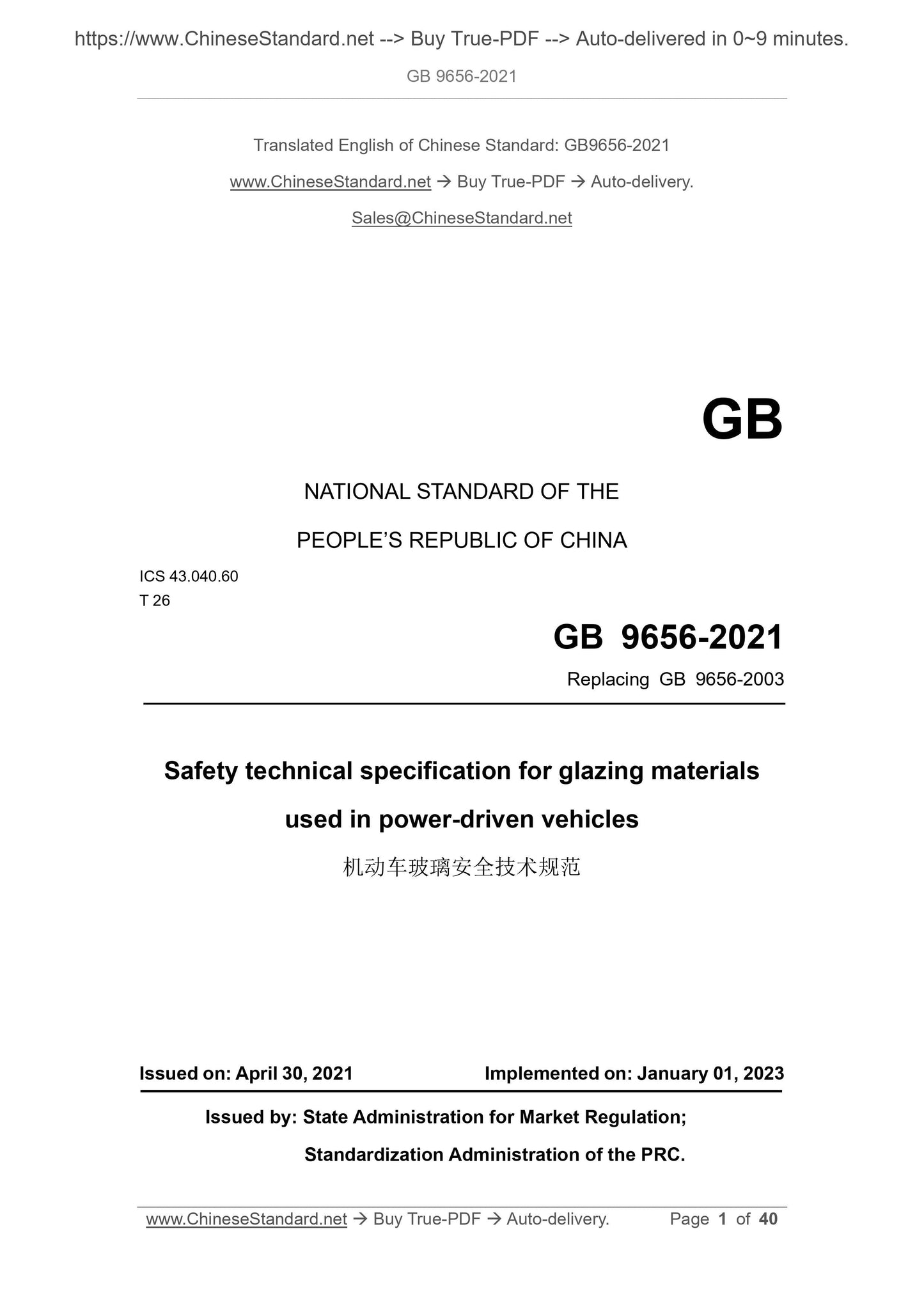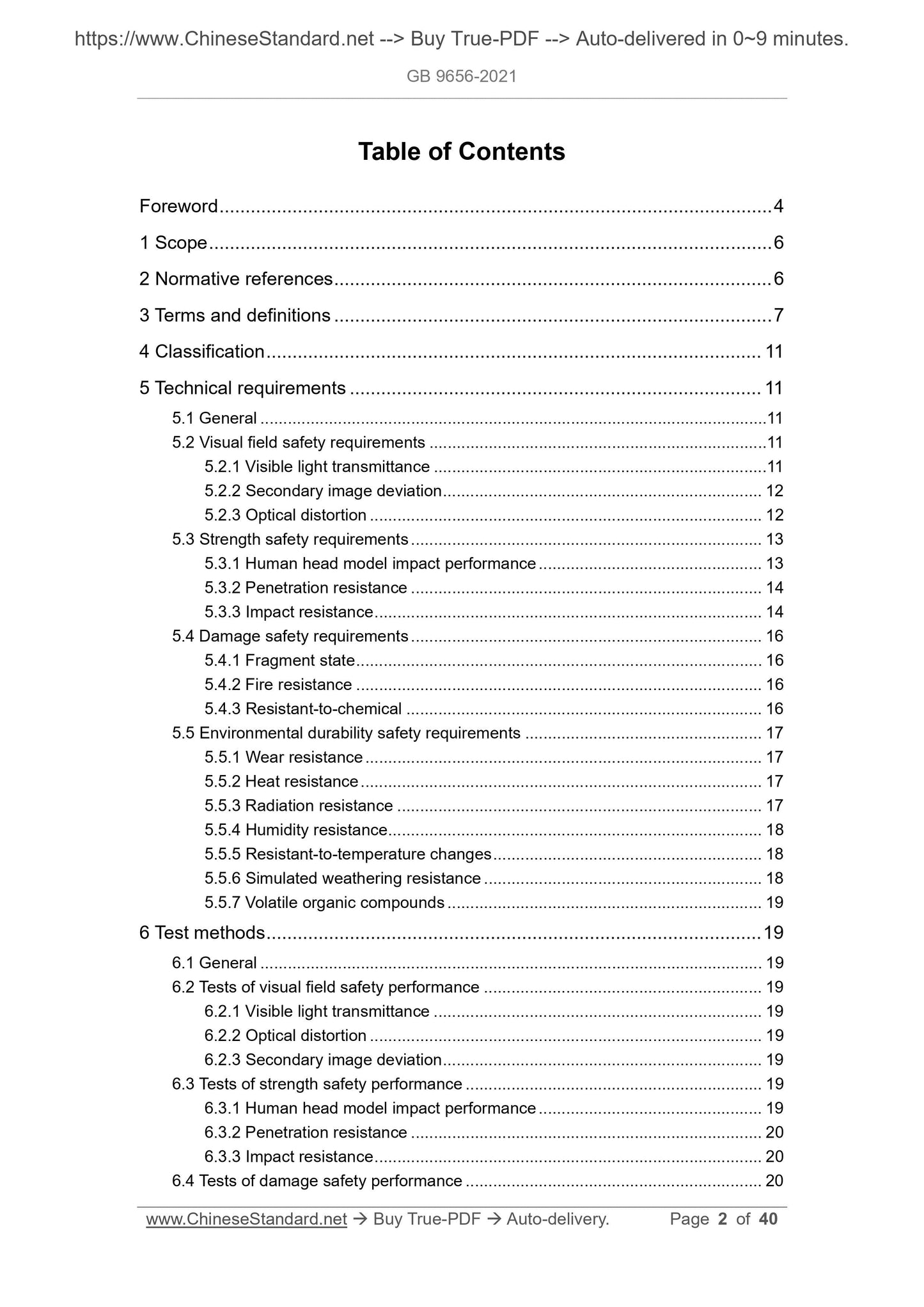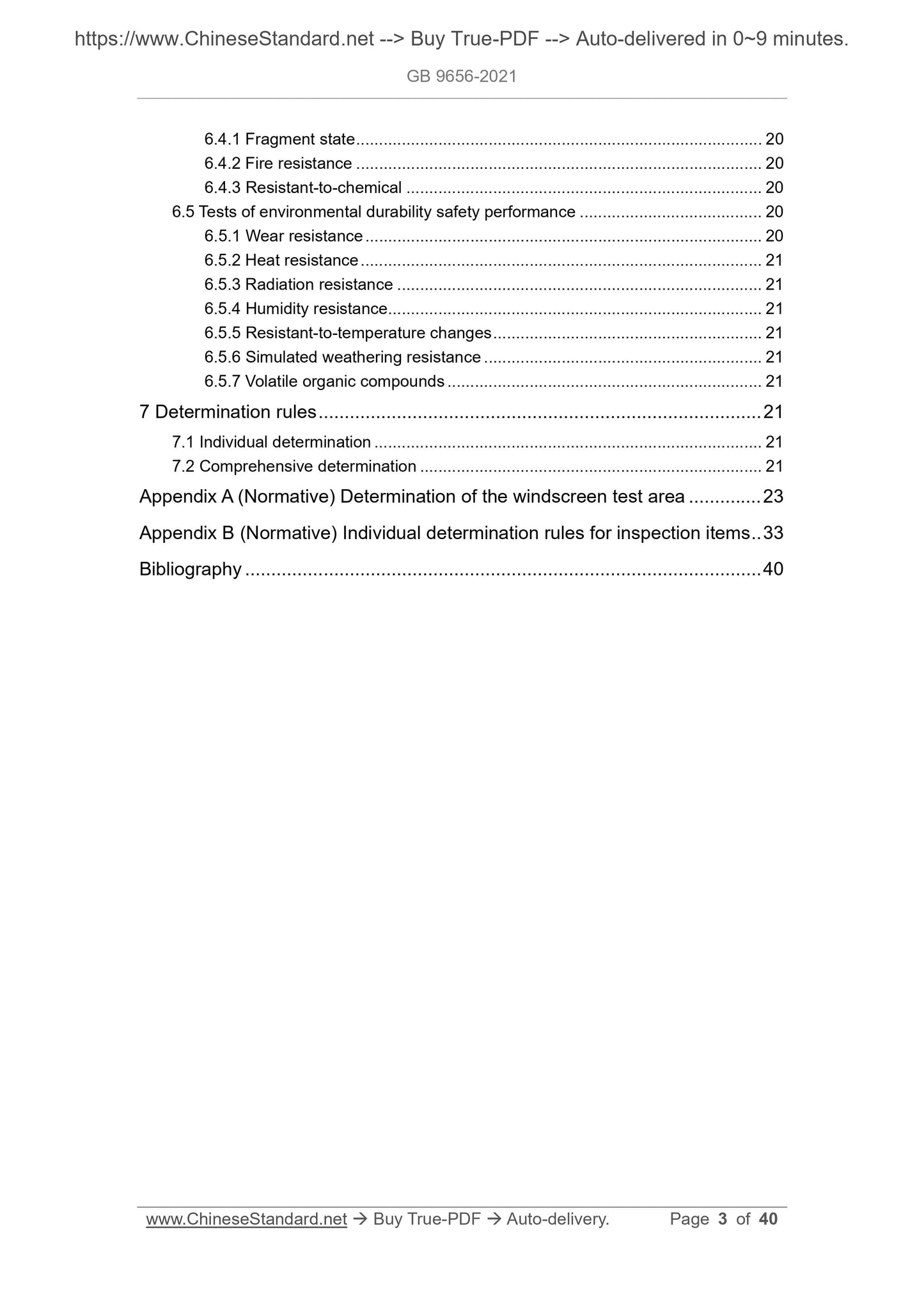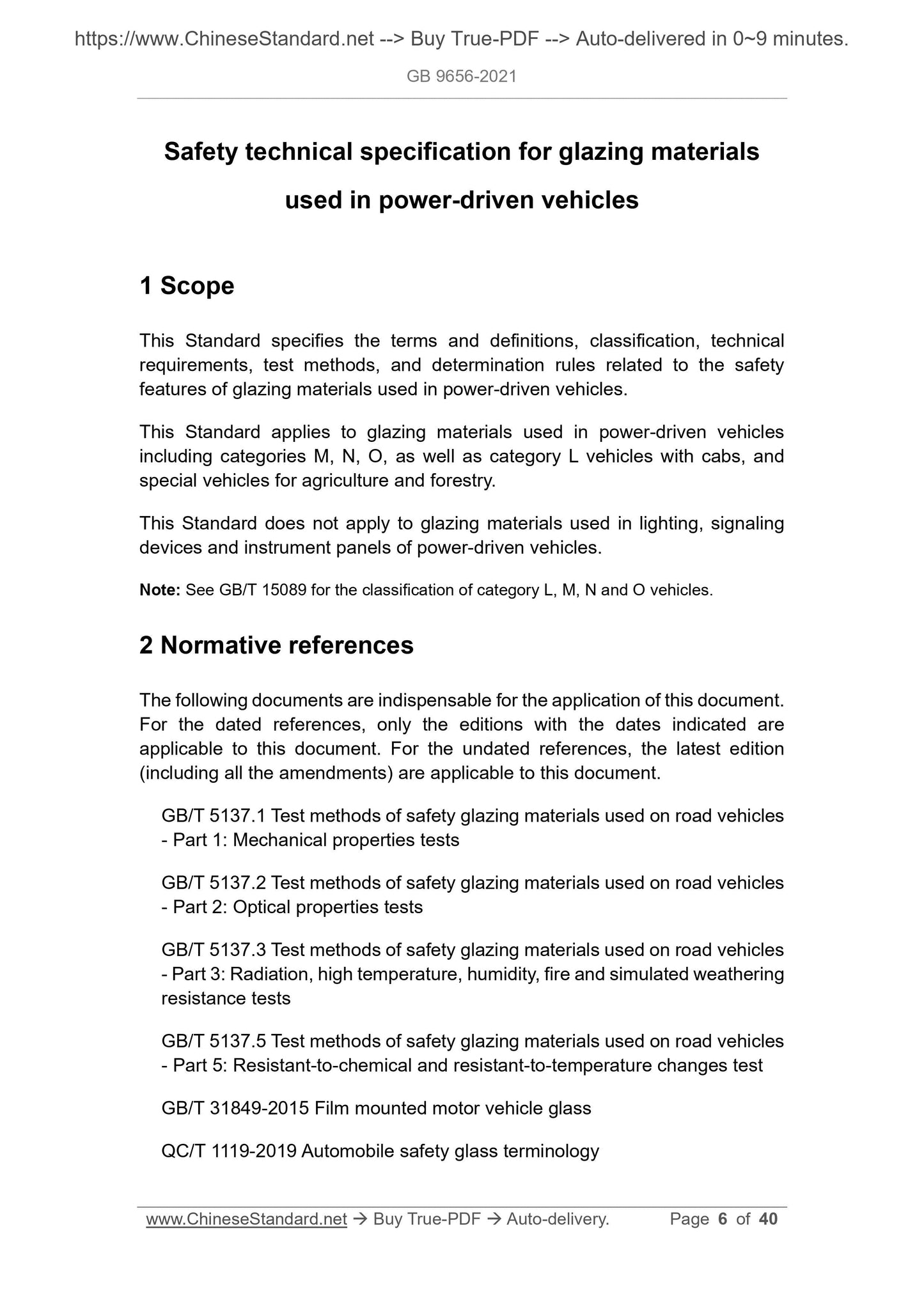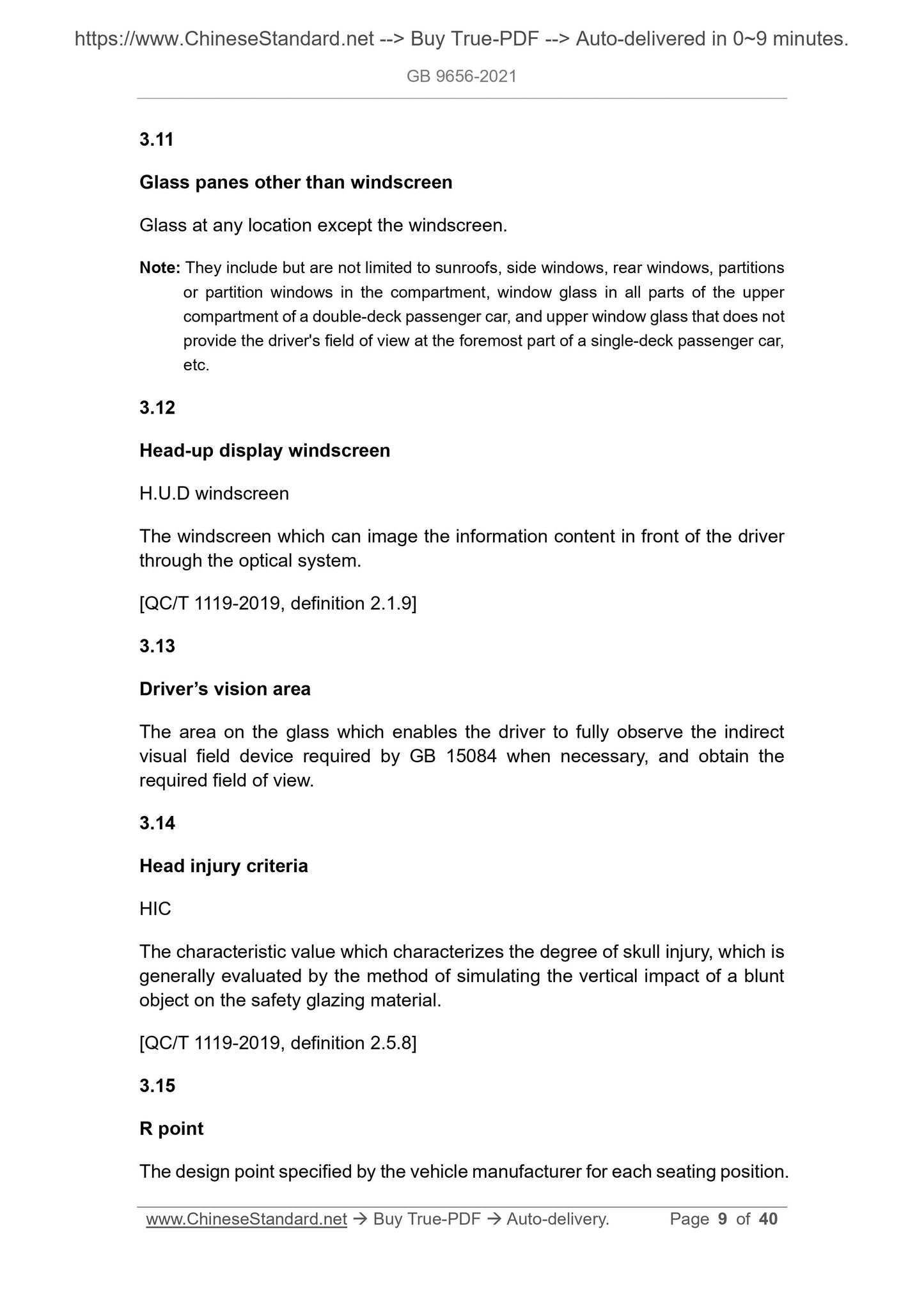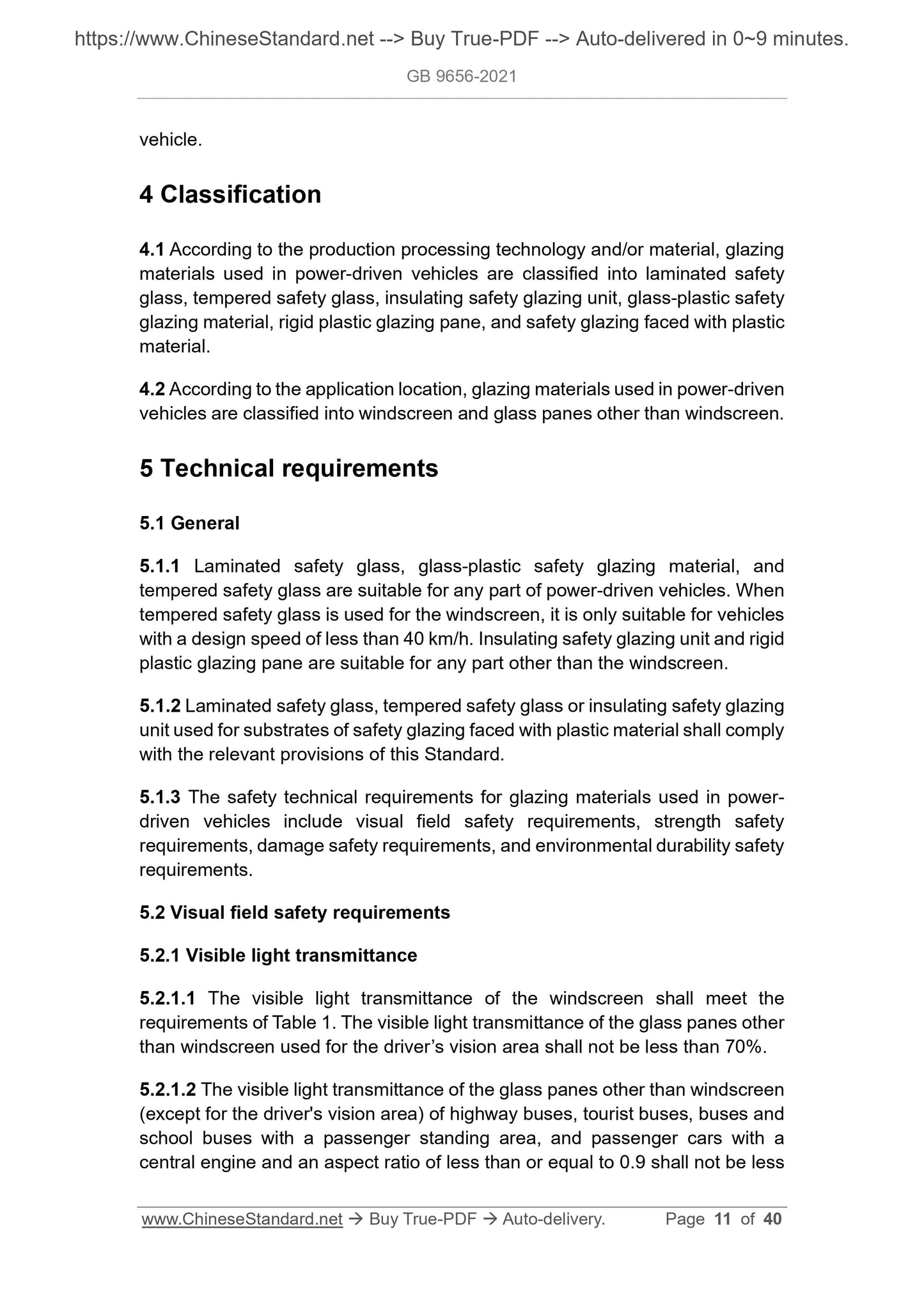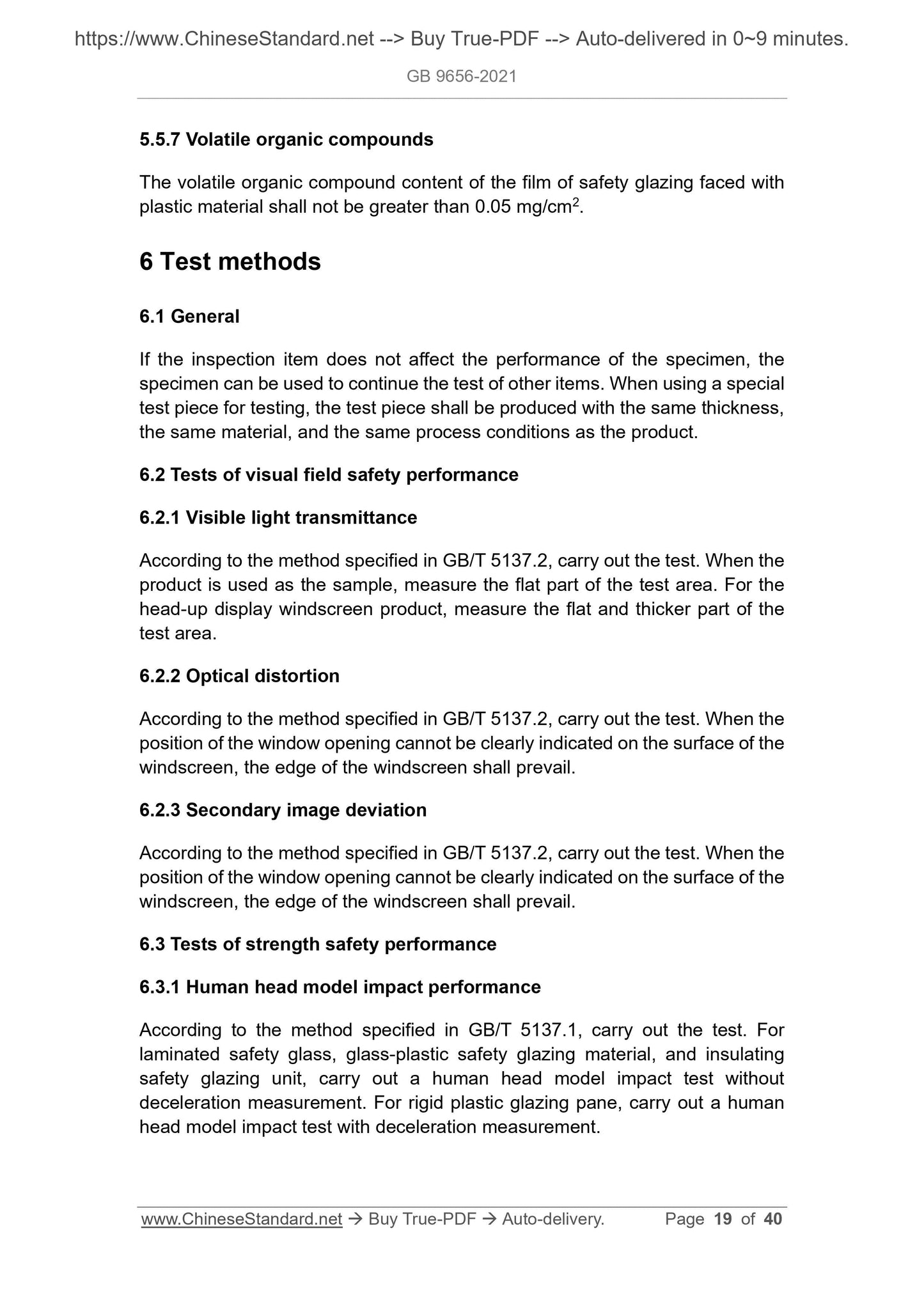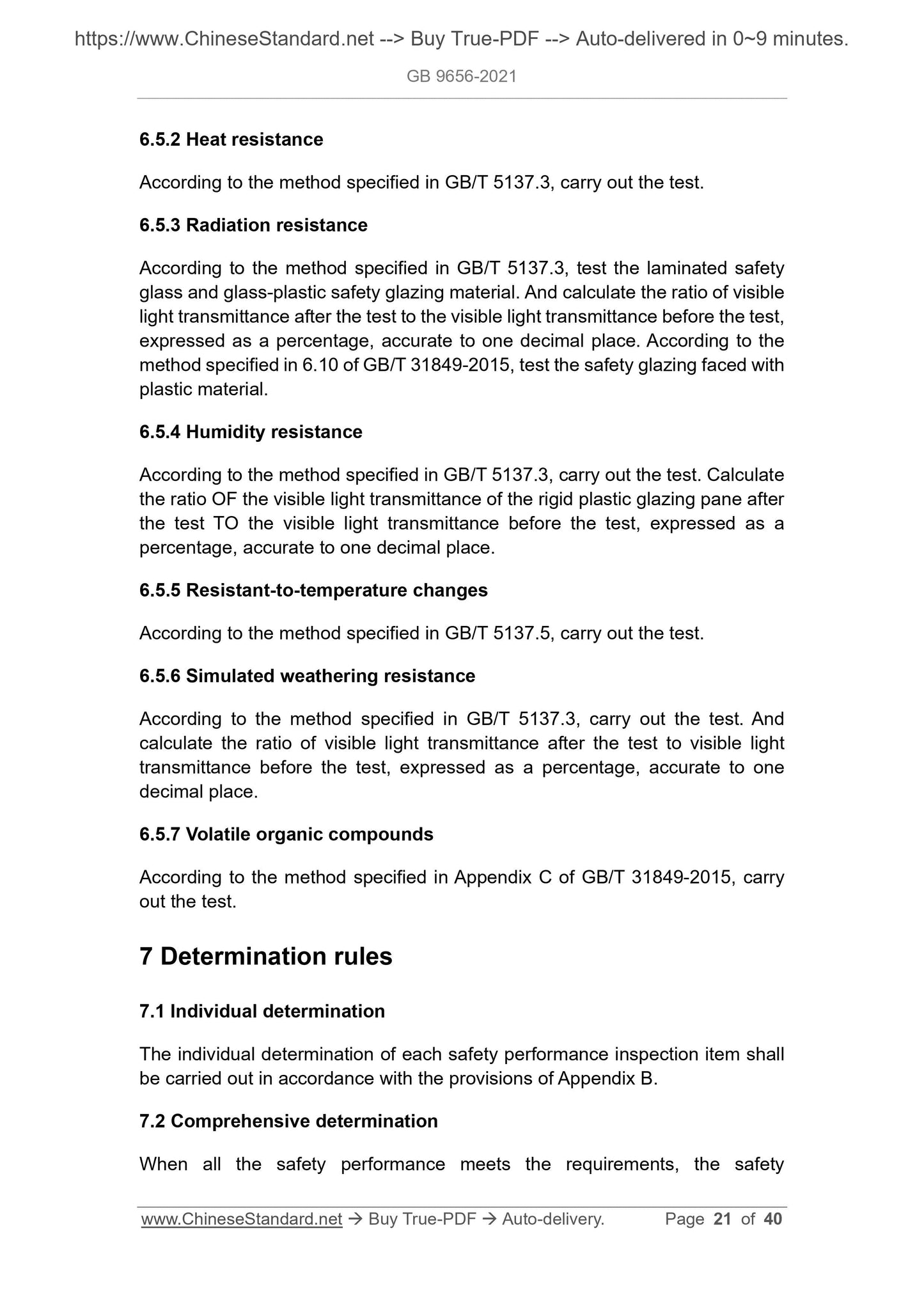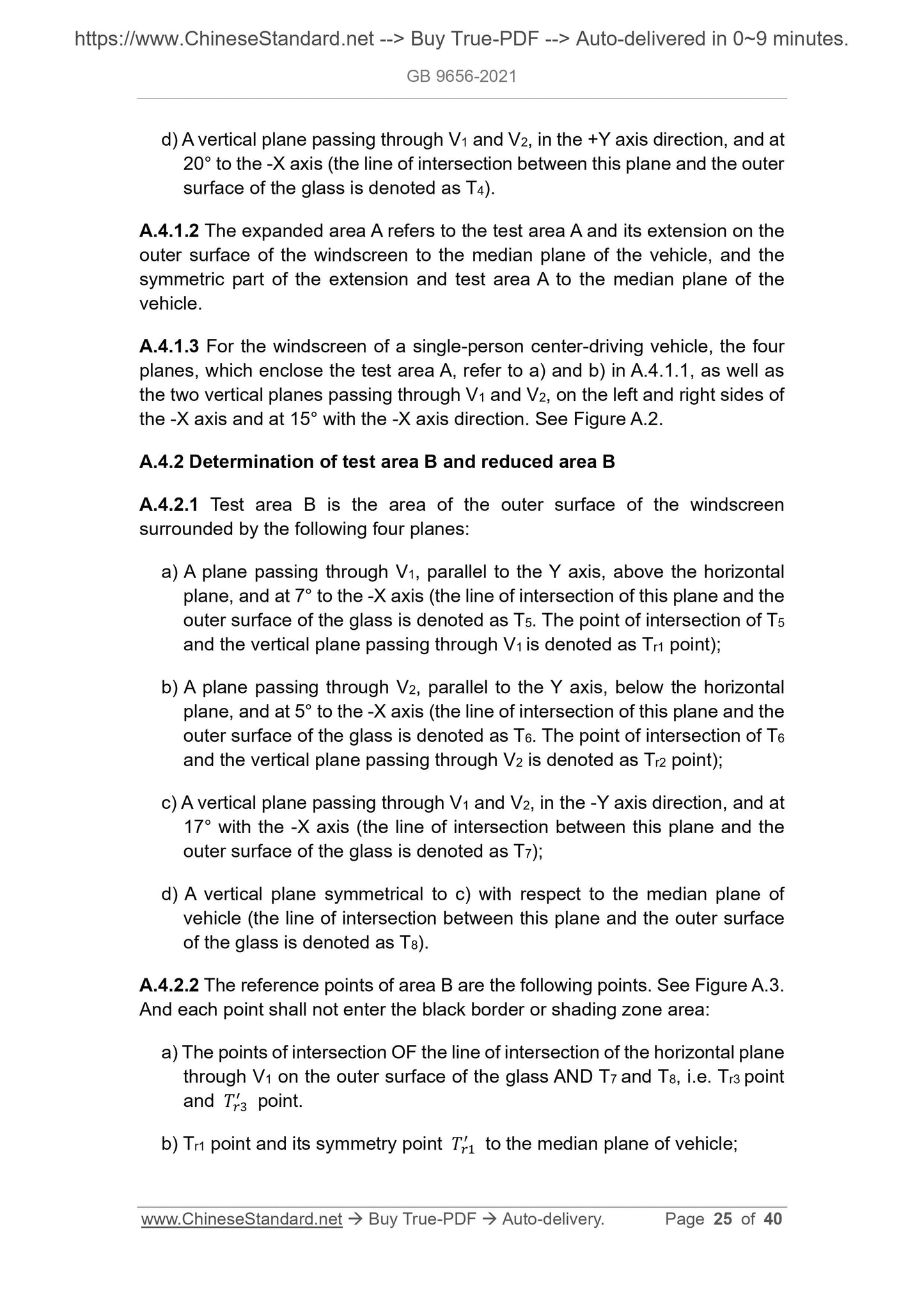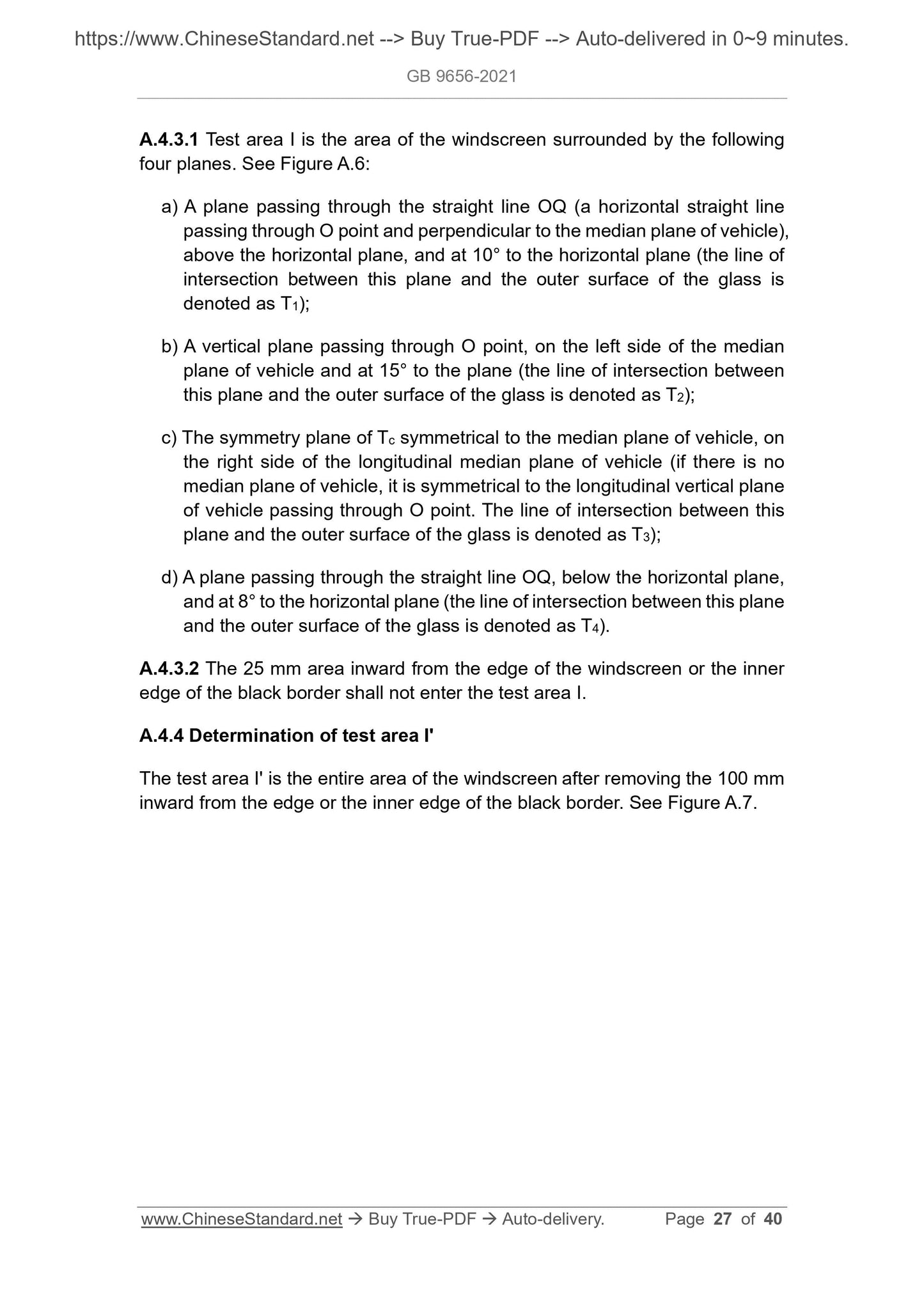1
/
의
10
PayPal, credit cards. Download editable-PDF & invoice in 1 second!
GB 9656-2021 English PDF (GB9656-2021)
GB 9656-2021 English PDF (GB9656-2021)
정가
$430.00 USD
정가
할인가
$430.00 USD
단가
/
단위
배송료는 결제 시 계산됩니다.
픽업 사용 가능 여부를 로드할 수 없습니다.
Delivery: 3 seconds. Download true-PDF + Invoice.
Get QUOTATION in 1-minute: Click GB 9656-2021
Historical versions: GB 9656-2021
Preview True-PDF (Reload/Scroll if blank)
GB 9656-2021: Safety technical specification for glazing materials used in power-driven vehicles
GB 9656-2021
GB
NATIONAL STANDARD OF THE
PEOPLE’S REPUBLIC OF CHINA
ICS 43.040.60
T 26
Replacing GB 9656-2003
Safety technical specification for glazing materials
used in power-driven vehicles
ISSUED ON: APRIL 30, 2021
IMPLEMENTED ON: JANUARY 01, 2023
Issued by: State Administration for Market Regulation;
Standardization Administration of the PRC.
Table of Contents
Foreword ... 4
1 Scope ... 6
2 Normative references ... 6
3 Terms and definitions ... 7
4 Classification ... 11
5 Technical requirements ... 11
5.1 General ... 11
5.2 Visual field safety requirements ... 11
5.2.1 Visible light transmittance ... 11
5.2.2 Secondary image deviation ... 12
5.2.3 Optical distortion ... 12
5.3 Strength safety requirements ... 13
5.3.1 Human head model impact performance ... 13
5.3.2 Penetration resistance ... 14
5.3.3 Impact resistance ... 14
5.4 Damage safety requirements ... 16
5.4.1 Fragment state ... 16
5.4.2 Fire resistance ... 16
5.4.3 Resistant-to-chemical ... 16
5.5 Environmental durability safety requirements ... 17
5.5.1 Wear resistance ... 17
5.5.2 Heat resistance ... 17
5.5.3 Radiation resistance ... 17
5.5.4 Humidity resistance ... 18
5.5.5 Resistant-to-temperature changes ... 18
5.5.6 Simulated weathering resistance ... 18
5.5.7 Volatile organic compounds ... 19
6 Test methods ... 19
6.1 General ... 19
6.2 Tests of visual field safety performance ... 19
6.2.1 Visible light transmittance ... 19
6.2.2 Optical distortion ... 19
6.2.3 Secondary image deviation ... 19
6.3 Tests of strength safety performance ... 19
6.3.1 Human head model impact performance ... 19
6.3.2 Penetration resistance ... 20
6.3.3 Impact resistance ... 20
6.4 Tests of damage safety performance ... 20
6.4.1 Fragment state ... 20
6.4.2 Fire resistance ... 20
6.4.3 Resistant-to-chemical ... 20
6.5 Tests of environmental durability safety performance ... 20
6.5.1 Wear resistance ... 20
6.5.2 Heat resistance ... 21
6.5.3 Radiation resistance ... 21
6.5.4 Humidity resistance ... 21
6.5.5 Resistant-to-temperature changes ... 21
6.5.6 Simulated weathering resistance ... 21
6.5.7 Volatile organic compounds ... 21
7 Determination rules ... 21
7.1 Individual determination ... 21
7.2 Comprehensive determination ... 21
Appendix A (Normative) Determination of the windscreen test area ... 23
Appendix B (Normative) Individual determination rules for inspection items .. 33
Bibliography ... 40
Safety technical specification for glazing materials
used in power-driven vehicles
1 Scope
This Standard specifies the terms and definitions, classification, technical
requirements, test methods, and determination rules related to the safety
features of glazing materials used in power-driven vehicles.
This Standard applies to glazing materials used in power-driven vehicles
including categories M, N, O, as well as category L vehicles with cabs, and
special vehicles for agriculture and forestry.
This Standard does not apply to glazing materials used in lighting, signaling
devices and instrument panels of power-driven vehicles.
Note: See GB/T 15089 for the classification of category L, M, N and O vehicles.
2 Normative references
The following documents are indispensable for the application of this document.
For the dated references, only the editions with the dates indicated are
applicable to this document. For the undated references, the latest edition
(including all the amendments) are applicable to this document.
GB/T 5137.1 Test methods of safety glazing materials used on road vehicles
- Part 1: Mechanical properties tests
GB/T 5137.2 Test methods of safety glazing materials used on road vehicles
- Part 2: Optical properties tests
GB/T 5137.3 Test methods of safety glazing materials used on road vehicles
- Part 3: Radiation, high temperature, humidity, fire and simulated weathering
resistance tests
GB/T 5137.5 Test methods of safety glazing materials used on road vehicles
- Part 5: Resistant-to-chemical and resistant-to-temperature changes test
GB/T 31849-2015 Film mounted motor vehicle glass
QC/T 1119-2019 Automobile safety glass terminology
3.11
Glass panes other than windscreen
Glass at any location except the windscreen.
Note: They include but are not limited to sunroofs, side windows, rear windows, partitions
or partition windows in the compartment, window glass in all parts of the upper
compartment of a double-deck passenger car, and upper window glass that does not
provide the driver's field of view at the foremost part of a single-deck passenger car,
etc.
3.12
Head-up display windscreen
H.U.D windscreen
The windscreen which can image the information content in front of the driver
through the optical system.
[QC/T 1119-2019, definition 2.1.9]
3.13
Driver’s vision area
The area on the glass which enables the driver to fully observe the indirect
visual field device required by GB 15084 when necessary, and obtain the
required field of view.
3.14
Head injury criteria
HIC
The characteristic value which characterizes the degree of skull injury, which is
generally evaluated by the method of simulating the vertical impact of a blunt
object on the safety glazing material.
[QC/T 1119-2019, definition 2.5.8]
3.15
R point
The design point specified by the vehicle manufacturer for each seating position.
vehicle.
4 Classification
4.1 According to the production processing technology and/or material, glazing
materials used in power-driven vehicles are classified into laminated safety
glass, tempered safety glass, insulating safety glazing unit, glass-plastic safety
glazing material, rigid plastic glazing pane, and safety glazing faced with plastic
material.
4.2 According to the application location, glazing materials used in power-driven
vehicles are classified into windscreen and glass panes other than windscreen.
5 Technical requirements
5.1 General
5.1.1 Laminated safety glass, glass-plastic safety glazing material, and
tempered safety glass are suitable for any part of power-driven vehicles. When
tempered safety glass is used for the windscreen, it is only suitable for vehicles
with a design speed of less than 40 km/h. Insulating safety glazing unit and rigid
plastic glazing pane are suitable for any part other than the windscreen.
5.1.2 Laminated safety glass, tempered safety glass or insulating safety glazing
unit used for substrates of safety glazing faced with plastic material shall comply
with the relevant provisions of this Standard.
5.1.3 The safety technical requirements for glazing materials used in power-
driven vehicles include visual field safety requirements, strength safety
requirements, damage safety requirements, and environmental durability safety
requirements.
5.2 Visual field safety requirements
5.2.1 Visible light transmittance
5.2.1.1 The visible light transmittance of the windscreen shall meet the
requirements of Table 1. The visible light transmittance of the glass panes other
than windscreen used for the driver’s vision area shall not be less than 70%.
5.2.1.2 The visible light transmittance of the glass panes other than windscreen
(except for the driver's vision area) of highway buses, tourist buses, buses and
school buses with a passenger standing area, and passeng...
Get QUOTATION in 1-minute: Click GB 9656-2021
Historical versions: GB 9656-2021
Preview True-PDF (Reload/Scroll if blank)
GB 9656-2021: Safety technical specification for glazing materials used in power-driven vehicles
GB 9656-2021
GB
NATIONAL STANDARD OF THE
PEOPLE’S REPUBLIC OF CHINA
ICS 43.040.60
T 26
Replacing GB 9656-2003
Safety technical specification for glazing materials
used in power-driven vehicles
ISSUED ON: APRIL 30, 2021
IMPLEMENTED ON: JANUARY 01, 2023
Issued by: State Administration for Market Regulation;
Standardization Administration of the PRC.
Table of Contents
Foreword ... 4
1 Scope ... 6
2 Normative references ... 6
3 Terms and definitions ... 7
4 Classification ... 11
5 Technical requirements ... 11
5.1 General ... 11
5.2 Visual field safety requirements ... 11
5.2.1 Visible light transmittance ... 11
5.2.2 Secondary image deviation ... 12
5.2.3 Optical distortion ... 12
5.3 Strength safety requirements ... 13
5.3.1 Human head model impact performance ... 13
5.3.2 Penetration resistance ... 14
5.3.3 Impact resistance ... 14
5.4 Damage safety requirements ... 16
5.4.1 Fragment state ... 16
5.4.2 Fire resistance ... 16
5.4.3 Resistant-to-chemical ... 16
5.5 Environmental durability safety requirements ... 17
5.5.1 Wear resistance ... 17
5.5.2 Heat resistance ... 17
5.5.3 Radiation resistance ... 17
5.5.4 Humidity resistance ... 18
5.5.5 Resistant-to-temperature changes ... 18
5.5.6 Simulated weathering resistance ... 18
5.5.7 Volatile organic compounds ... 19
6 Test methods ... 19
6.1 General ... 19
6.2 Tests of visual field safety performance ... 19
6.2.1 Visible light transmittance ... 19
6.2.2 Optical distortion ... 19
6.2.3 Secondary image deviation ... 19
6.3 Tests of strength safety performance ... 19
6.3.1 Human head model impact performance ... 19
6.3.2 Penetration resistance ... 20
6.3.3 Impact resistance ... 20
6.4 Tests of damage safety performance ... 20
6.4.1 Fragment state ... 20
6.4.2 Fire resistance ... 20
6.4.3 Resistant-to-chemical ... 20
6.5 Tests of environmental durability safety performance ... 20
6.5.1 Wear resistance ... 20
6.5.2 Heat resistance ... 21
6.5.3 Radiation resistance ... 21
6.5.4 Humidity resistance ... 21
6.5.5 Resistant-to-temperature changes ... 21
6.5.6 Simulated weathering resistance ... 21
6.5.7 Volatile organic compounds ... 21
7 Determination rules ... 21
7.1 Individual determination ... 21
7.2 Comprehensive determination ... 21
Appendix A (Normative) Determination of the windscreen test area ... 23
Appendix B (Normative) Individual determination rules for inspection items .. 33
Bibliography ... 40
Safety technical specification for glazing materials
used in power-driven vehicles
1 Scope
This Standard specifies the terms and definitions, classification, technical
requirements, test methods, and determination rules related to the safety
features of glazing materials used in power-driven vehicles.
This Standard applies to glazing materials used in power-driven vehicles
including categories M, N, O, as well as category L vehicles with cabs, and
special vehicles for agriculture and forestry.
This Standard does not apply to glazing materials used in lighting, signaling
devices and instrument panels of power-driven vehicles.
Note: See GB/T 15089 for the classification of category L, M, N and O vehicles.
2 Normative references
The following documents are indispensable for the application of this document.
For the dated references, only the editions with the dates indicated are
applicable to this document. For the undated references, the latest edition
(including all the amendments) are applicable to this document.
GB/T 5137.1 Test methods of safety glazing materials used on road vehicles
- Part 1: Mechanical properties tests
GB/T 5137.2 Test methods of safety glazing materials used on road vehicles
- Part 2: Optical properties tests
GB/T 5137.3 Test methods of safety glazing materials used on road vehicles
- Part 3: Radiation, high temperature, humidity, fire and simulated weathering
resistance tests
GB/T 5137.5 Test methods of safety glazing materials used on road vehicles
- Part 5: Resistant-to-chemical and resistant-to-temperature changes test
GB/T 31849-2015 Film mounted motor vehicle glass
QC/T 1119-2019 Automobile safety glass terminology
3.11
Glass panes other than windscreen
Glass at any location except the windscreen.
Note: They include but are not limited to sunroofs, side windows, rear windows, partitions
or partition windows in the compartment, window glass in all parts of the upper
compartment of a double-deck passenger car, and upper window glass that does not
provide the driver's field of view at the foremost part of a single-deck passenger car,
etc.
3.12
Head-up display windscreen
H.U.D windscreen
The windscreen which can image the information content in front of the driver
through the optical system.
[QC/T 1119-2019, definition 2.1.9]
3.13
Driver’s vision area
The area on the glass which enables the driver to fully observe the indirect
visual field device required by GB 15084 when necessary, and obtain the
required field of view.
3.14
Head injury criteria
HIC
The characteristic value which characterizes the degree of skull injury, which is
generally evaluated by the method of simulating the vertical impact of a blunt
object on the safety glazing material.
[QC/T 1119-2019, definition 2.5.8]
3.15
R point
The design point specified by the vehicle manufacturer for each seating position.
vehicle.
4 Classification
4.1 According to the production processing technology and/or material, glazing
materials used in power-driven vehicles are classified into laminated safety
glass, tempered safety glass, insulating safety glazing unit, glass-plastic safety
glazing material, rigid plastic glazing pane, and safety glazing faced with plastic
material.
4.2 According to the application location, glazing materials used in power-driven
vehicles are classified into windscreen and glass panes other than windscreen.
5 Technical requirements
5.1 General
5.1.1 Laminated safety glass, glass-plastic safety glazing material, and
tempered safety glass are suitable for any part of power-driven vehicles. When
tempered safety glass is used for the windscreen, it is only suitable for vehicles
with a design speed of less than 40 km/h. Insulating safety glazing unit and rigid
plastic glazing pane are suitable for any part other than the windscreen.
5.1.2 Laminated safety glass, tempered safety glass or insulating safety glazing
unit used for substrates of safety glazing faced with plastic material shall comply
with the relevant provisions of this Standard.
5.1.3 The safety technical requirements for glazing materials used in power-
driven vehicles include visual field safety requirements, strength safety
requirements, damage safety requirements, and environmental durability safety
requirements.
5.2 Visual field safety requirements
5.2.1 Visible light transmittance
5.2.1.1 The visible light transmittance of the windscreen shall meet the
requirements of Table 1. The visible light transmittance of the glass panes other
than windscreen used for the driver’s vision area shall not be less than 70%.
5.2.1.2 The visible light transmittance of the glass panes other than windscreen
(except for the driver's vision area) of highway buses, tourist buses, buses and
school buses with a passenger standing area, and passeng...
Share
